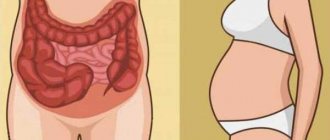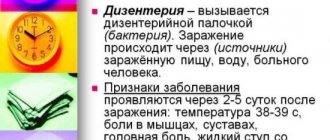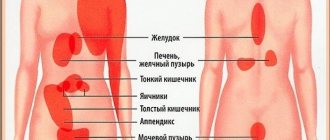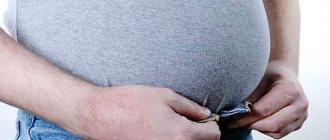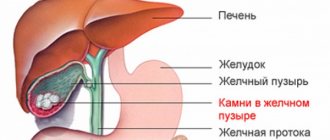The main causes of pain in the lower abdomen
Pain in the lower abdomen of various locations appears due to natural physiological processes in the body.
The following violations can provoke it:
- diseases of the uterus and ovaries: endometriosis, fibroids, adnexitis, cysts and ovarian apoplexy and others;
- wearing tight-fitting clothes and underwear that compress the stomach;
- pathologies of the urinary system, intestines, stomach, kidneys: with cystitis, pyelonephritis, cholecystitis, inflammation of the ureter;
- conditions requiring urgent surgical intervention for inflammation of the appendix;
- foreign bodies in the uterus: in particular, the ingrowth of the IUD, as well as inflammation due to its improper use;
- pathologies of pregnancy: placental abruption, frozen embryo and miscarriage in progress, ectopic pregnancy, consequences of abortion or surgery.
Most often, unpleasant sensations appear with increased gas formation, intestinal dysfunction, muscle tone and ligaments during pregnancy. The pain can cover the entire bottom or be focused on one side. Many people have no idea what this could be.
Types of pain
The cause can be determined by the nature of the pain and additional symptoms, as well as by the clinical dynamics. The diagnosis is made after examination by a specialist, tests and hardware diagnostics to determine why the woman’s right lower abdomen hurts.
Pain occurs in the following conditions:
- bleeding that is not menstruation, combined with dull pain, is a sign of inflammatory processes in the reproductive system;
- the infectious nature is indicated by the appearance of temperature and pathological discharge from the vagina;
- with diseases of the stomach and intestines, nausea and vomiting additionally appear, the temperature may rise, and there is no appetite;
- severe pain in the right side of varying intensity, it either increases or subsides, is a sign of appendicitis.
The disease can be chronic or acute. This is indicated by the duration of the pain and frequency.
An exacerbation of chronic diseases is indicated by an acute pain syndrome that does not stop for several hours.
Diagnostic measures
The cause of pain is determined by the doctor based on diagnostic data. First, an examination, collection of complaints and anamnesis, and manual examination are carried out. Based on this, the doctor makes a preliminary diagnosis and prescribes additional diagnostic procedures:
- A general blood test will determine the infectious nature of the pathology;
- general urinalysis - will show diseases of the excretory system;
- biochemical blood test - to assess liver function;
- Ultrasound - reveals changes in the soft tissues of internal organs;
- MRI - determines the smallest pathologies, their nature and location;
- x-ray - reveals damage to bone tissue, determine gas in the abdominal cavity (if the gastrointestinal tract is damaged);
- colonoscopy, irrigoscopy - assessment of intestinal condition.
Based on the examination data, a final diagnosis is made. On its basis, patient management tactics are developed and built.
Pain due to appendicitis and kidney disease
With appendicitis, pain can be localized in the iliac region and also radiate to the side. In the first stages of the disease, it appears in the epigastric region, shifts to the right, and can radiate to the back and other parts of the abdominal cavity.
There are different sensations: cutting, dull or aching pain. They are accompanied by deterioration of health, chills, and nausea. The sensations can be confused with the condition of adnexitis and inflammation of the bladder.
You can suspect appendicitis by doing a test. When tapping on the ilium, pain occurs on the right side, which never spreads to the left side. It intensifies with palpation at the point of origin and with coughing. If you lie on your right side with your knees bent, it becomes easier. When moving to the left side, the pain intensifies.
Kidney disease causes acute pain that radiates to the back. They resemble a lumbago, aching sensation. Urinary retention may occur, up to anuria, swelling, shortness of breath, pain when urinating, and blood pressure may increase. When the right kidney prolapses, there is pain in the side on the side of the pathological kidney when walking and moving.
Diseases of the reproductive system
The inflammatory process is accompanied by fever and pain. With adnexitis, it is felt in the lower abdomen, moving to the side. With salpingoophoritis, it is constant and aching in nature. Treatment is carried out only after examination. Antibiotics are prescribed.
With endometriosis, not only the body of the uterus can be affected, but also the appendages, as well as the space behind the cervix. Most often, pain occurs before and during menstruation.
Depending on the stage of the disease, the intensity and nature of the sensations may vary. The pain may radiate to the groin or pubis.
During the adhesive process, the pain intensity increases.
Pregnancy and complications
Nagging pain during early pregnancy is common. The reason is the gradual enlargement of the uterus and muscle tone. They can also be provoked by increased stress, when the expectant mother spends a lot of time on her feet.
The pain is not dangerous, but it cannot be ignored. If the pain is not accompanied by additional symptoms, it does not require treatment. It’s enough just to reduce physical activity and relax. If they intensify and become like contractions, you should seek medical help immediately.
When placental abruption occurs, pain is accompanied by spotting. If there is a threat of miscarriage, it is intense and there may be no bleeding. Bleeding occurs when a miscarriage is in progress.
With pathologies of pregnancy, pain often radiates to the anus.
Periodic training contractions in the later stages are painless tensions of the uterine walls. This is a normal physiological process that does not require drug treatment. If it is accompanied by any pain, you should consult a doctor.
Uterine fibroids
Fibroids cause pain when they become large. Unpleasant sensations arise due to the pressure of the tumor on other organs. If the node is rejected, sharp pain appears, reminiscent of contractions. Bleeding appears. Treatment consists of removing the tumor.
Ovarian cyst
With a cyst, acute pain indicates a rupture of its shell, or twisting of the floating leg. This condition requires emergency treatment. Twisting occurs during active sports, falls, or sudden movements. This condition is accompanied by nagging pain in the side of the affected ovary.
When the leg is completely twisted, tissue death occurs due to the outflow of blood. Sharp pain appears in the form of contractions. The temperature rises and the body becomes intoxicated.
Urgent surgical intervention is required.
Ovarian apoplexy
Apoplexy appears during ovulation, when a follicle ruptures in the ovary. In this case, the walls of the blood vessels are damaged and hemorrhage occurs in the abdominal cavity. The disease occurs as a result of traumatic sexual intercourse, vascular pathology, prolonged inflammatory processes, heavy lifting, and abdominal injuries. Acute pain in the side is accompanied by decreased pressure and pale skin. Possible fainting.
Apoplexy is life-threatening and requires medical attention.
Algodisminorrhea
This disease is characteristic of a young body during puberty. It manifests itself as pain before the onset of menstruation. Soreness requires careful diagnosis. It also indicates a bent uterus, endometritis, inflammatory processes of the reproductive system, and premenstrual syndrome.
Pain between periods
Discomfort in the middle of the cycle occurs in 10% of women. It manifests itself as a prickly pain on the part of the ovary involved in ovulation. Pain occurs when the egg leaves the ovary. It lasts no more than 2 days.
The discharge becomes thicker and glass-like. Minor splashes of blood are allowed. You can relieve discomfort with antispasmodics, provided that pregnancy is not planned.
Pain after sex
Pain appears due to tissue swelling caused by a rapid rush of blood after sexual intercourse. Contraction of the uterus and vaginal walls does not occur at this moment. Intense movements of the partner cause injuries to the mucous membranes.
Inflammatory diseases, the presence of adhesions, endometritis, tumors and other pathologies aggravate the discomfort.
Sharp pain in the lower abdomen indicates acute and chronic diseases of the reproductive system.
Pulling and aching are physiological processes in the body that occur periodically on certain days.
Why does it hurt on the right side?
Physiological factors
Most often, the right side “pricks” during fast walking, running, or physical activity.
Painful sensations are caused by redistribution of blood flow, deposition of blood in the liver. Pain occurs at the moment of maximum load or immediately after training. Due to sharp stabbing sensations, the person stops and grabs his side. The discomfort disappears after a few minutes of rest. Pain in the right half of the abdomen often appears in untrained people who begin to intensively pump their abs. Myalgia develops and lasts 2-3 days. The pain becomes more severe when laughing, straining, or turning the body. Another common cause of myalgia and myositis is the effect of hypothermia or draft. In this case, the entire right side and lower back hurt, and the pain is aggravated by awkward movements.
Appendicitis
When the appendix becomes inflamed, severe pain occurs in the right ilium. The pain syndrome develops suddenly and is not associated with typical provoking factors. The pain is constant or cramping; to relieve it, the patient lies on his side with his legs pulled up to his stomach. Abdominal pain on the right is accompanied by increased body temperature and weakness. Sometimes there are dysuric and dyspeptic disorders.
With appendicular infiltrate, a different nature of pain is specific. Patients experience aching pain that lasts up to several weeks. The pain syndrome intensifies with bending of the torso and physical activity. Sometimes patients themselves feel a space-occupying formation in the right side, and when pressing on it, sharp pain is detected.
Mesadenitis
In the acute form of mesadenitis, pain in the right side begins suddenly. They bother a person for several days and are cramp-like in nature. Sometimes the pain spreads throughout the abdomen, and a person cannot indicate its exact location. Gradually, the pain becomes dull or aching, typically aggravated by coughing or changing position. The symptom is accompanied by fever, nausea and dry mouth, diarrhea.
Salmonellosis
With this intestinal infection, sharp spasmodic pain occurs in the upper abdomen and right side. In most cases, a “Salmonella triangle” is detected: patients complain of pain in the right iliac region, near the navel, and in the epigastrium. The intensity of symptoms increases before defecation. Simultaneously with the pain syndrome, repeated diarrhea develops, the stool becomes greenish and acquires a foul odor.
Helminthiasis
When infested with intestinal parasites, a person experiences periodic dull or cramping pain in the right side. They typically intensify in the evening and at night. Stool disorders, flatulence and rumbling in the stomach are observed. For helminthiasis, a combination of abdominal manifestations with other syndromes is typical: asthenovegetative, hepatolienal, bronchopulmonary.
Crohn's disease
The most common localization of the lesion is terminal ileitis, so pain occurs on the right side of the lower abdomen. During the period of exacerbation, the pain is acute, paroxysmal, and when the inflammatory process subsides, periodic aching sensations and discomfort in the specified area prevail. When the disease spreads to other parts of the intestine, the localization of the pain syndrome changes. Pain in the right side is accompanied by diarrhea with blood in the stool and weight loss.
Pain in right side
Hernias
Pain in the right lower abdomen is a sign of a right inguinal (usually in men) or femoral (usually in women) hernia. The intensity of pain depends on the size of the hernial protrusion and the presence of complications. Initially, dull pain in the right side is bothersome, aggravated by physical activity and straining. With strangulated hernias, the pain becomes severe and paroxysmal.
Intestinal tumors
Severe pain in the right flank of the abdomen is observed with cancer of the cecum or ascending colon. Pain as the first symptom of a tumor occurs in pseudo-inflammatory or enterocolitic forms of oncopathology. The pain syndrome persists constantly, periodically it intensifies to painful spasms. Pain in the side is combined with decreased appetite, weight loss, and the appearance of blood in the stool.
Damage to the female reproductive organs
In women, pain in the right iliac region is often associated with gynecological diseases. Their intensity varies from dull or aching sensations to severe cramps. In most patients, there is a clear connection between the nature and strength of the pain syndrome and the menstrual cycle. Typically, increased pain during sexual intercourse (dyspareunia). More often, pain in the right side is manifested by:
- Adnexitis.
When the process worsens, women complain of sharp pain in the right side, which radiates to the anus and perineum. Chronic inflammation is characterized by aching sensations that intensify before menstruation, after overwork or hypothermia. - Endometriosis.
Pain syndrome occurs when the right ovary or fallopian tube is damaged. With endometriosis, chronic pain on the right in the ilium and suprapubic area is bothersome. During menstruation, the pain intensifies and severe cramps occur. - Ovarian cyst.
When the space-occupying lesion is located on the right side, constant aching pain occurs in the corresponding half of the abdomen. Painful sensations intensify with physical activity, bending the body, and sexual intercourse. - Emergency conditions.
When an ovarian cyst ruptures or an ectopic pregnancy is terminated, severe cramping pain is observed on the right in the iliac region. The pain syndrome radiates to the perineum, sacrum, and anus.
Urolithiasis disease
Occasionally, unbearable pain in the right side is a symptom of renal colic. With ICD, the pain syndrome begins suddenly and quickly reaches maximum intensity. During an attack, patients are restless, rushing around the room, groaning in pain. Pain usually radiates to the lower back, thigh, and external genitalia. The symptom is accompanied by dysuric disorders, urine discharge of pink or red-brown color.
Pain radiating to the leg
Pain in the lower abdomen that radiates to the leg is a symptom of osteochondrosis. When the nerve process is pinched, posture is disrupted, which leads to malfunctions of organs and systems. Pain can occur in the back, in the groin with impulses in the leg.
With an inguinal and femoral hernia, acute pain occurs with movements and severe coughing. Upon palpation, a rounded formation is felt in the groin. A pinched hernia is additionally accompanied by weakness, nausea, dizziness, and blood pressure may rise or fall. Contact a doctor immediately.
What to do if you have pain in the lower abdomen on the right
Pain in the right side of the lower abdomen can be the cause of a serious illness that requires emergency treatment. Do not hesitate to visit the clinic. Untreated pathologies lead to complications with serious consequences. When making a diagnosis, the doctor prescribes:
- general blood and urine tests;
- smears from the cervical canal and vagina;
- Ultrasound of the pelvic organs, kidneys and liver;
- CTG and ECG, as well as other types of studies.
The doctor will find out why the woman’s right lower abdomen hurts and tell her how to treat it. During the treatment process, you should adhere to the recommendations and observe the regime. Self-medication masks the symptoms, which after a while leads to complications. It should be remembered that untimely contact with a gynecologist for diseases of the reproductive system often leads to infertility.
Tingling in the right side of a woman's lower abdomen
Painful tingling in the right side of the lower abdomen in a girl may be due to the following reasons:
- Enteritis and colitis. When the disease affects the small intestine, pain forms in the navel area and gradually descends below. Enteritis often forms during infection, but goes away after recovery.
- Acute pancreatitis. A dangerous condition associated with inflammation of the gastrointestinal tract. Changes occur in the pancreas. Surgical assistance is often required. Symptoms: blue lips, pale skin, fever, sharp pain on the right side, vomiting attacks, colic that persists even after taking painkillers.
- Cholecystitis, cholangitis and cholelithiasis. In case of gallbladder diseases, tingling sensations on the right side, yellowness of the skin, and a burning sensation are disturbing. However, most often the unpleasant symptoms are located above the lower abdomen.
- Peritonitis. It is difficult to confuse this condition with other disorders, since with peritonitis a person’s temperature rises sharply and he loses consciousness due to pain. Peritonitis can develop against the background of untimely operated appendicitis.
- Kidney failure. The symptoms are localized in the right quadrant of the abdomen; acute pain is felt when urinating, and blood may be present. Oligouria often develops, and uric acid enters the blood.
Stitching pain is also observed in patients with volvulus and intestinal obstruction. These conditions are accompanied by a lack of stool, general intoxication and other dangerous signs.



